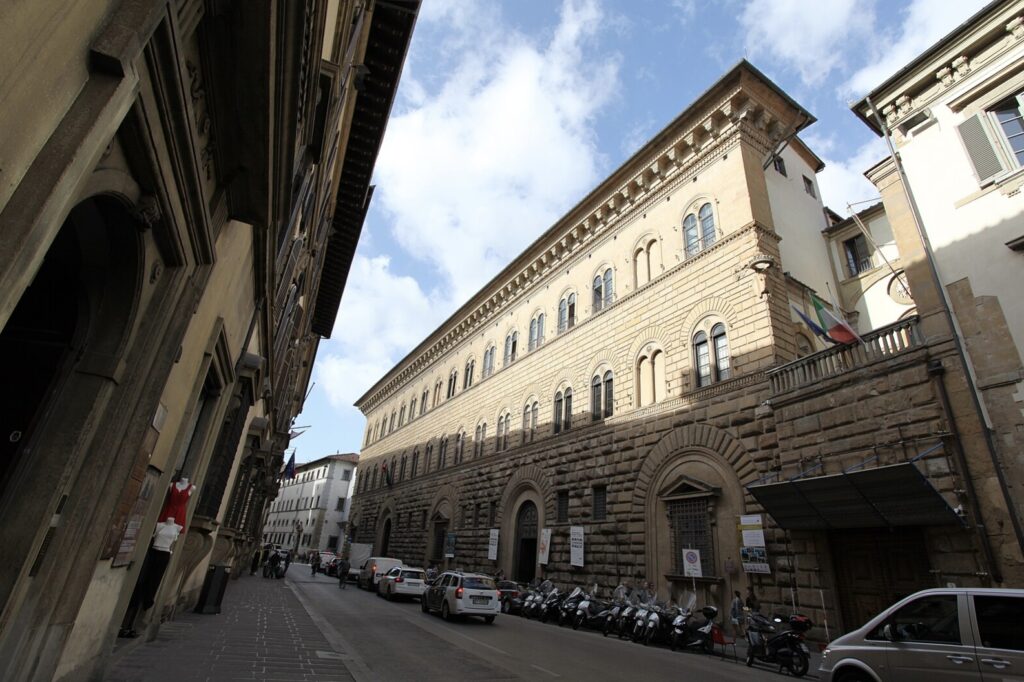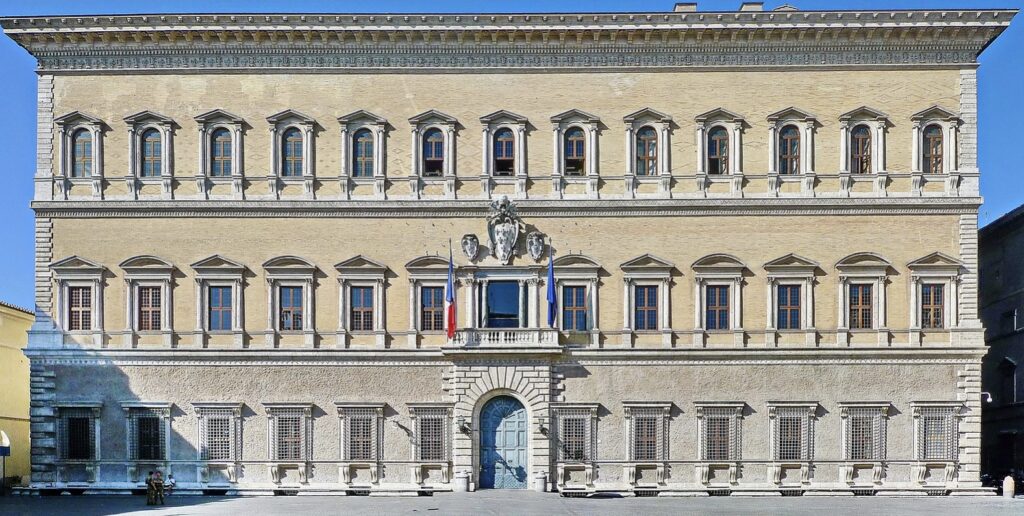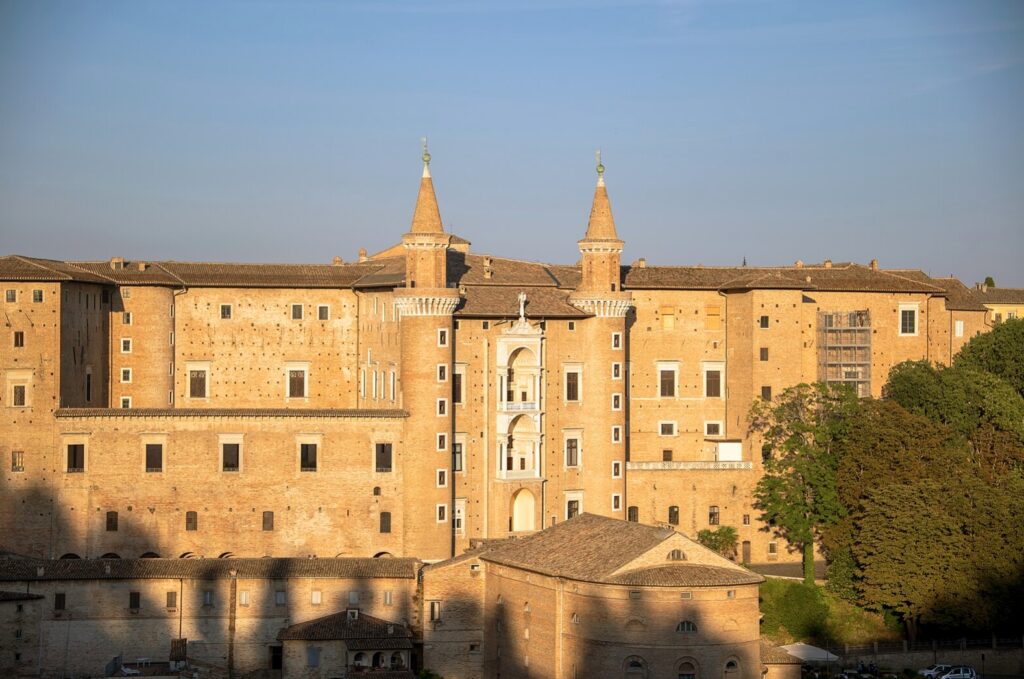In the heart of 15th-century Italy, among workshops filled with precious pigments and fervent intellectual debates, the concept of the Renaissance Palace took shape. In cities that teemed with ambitious merchants and bankers, this building became a symbol of an era of transformation and patronage.
The rediscovery of classical ideals, supported by the passionate reading of ancient texts, provided a solid theoretical basis. Humanistic thought, which placed the human being at the center of the universe, inspired an architectural style centered on order and balance. In this atmosphere, the first great Italian families wanted residences that reflected their status, but also their devotion to harmony.
The growth of the Signorie fostered the desire to celebrate the greatness of the rulers. The courts of Florence, Mantua, Ferrara and Urbino became places of reflection where artists, architects and men of letters met in a continuous creative ferment. The palace thus became a testimony to a power that wanted to appear solid and far-sighted.
The encounter between architecture and mathematics became more intense: perspective, proportion and geometry were adopted as guiding principles. The palace is transformed into a perfect synthesis of figurative arts and scientific rationality, reflecting the desire to define a measurable and replicable beauty.
Some architects, such as Leon Battista Alberti, precisely theorize the rules of ideal architecture, contemplating columns, capitals and decorations that recall classical antiquity. The observation of Roman ruins becomes the fuse that triggers a new interpretation of living, no longer just defensive or fortified, but also aesthetic.
The concept of “urban dwelling” takes on connotations never seen before. Palaces cease to be merely functional places for the management of fiefdoms and are transformed into real artistic laboratories, where construction techniques and decorative solutions are experimented. The need to amaze illustrious guests is mixed with the desire to define a new architectural language.
At the time, the clients were also essential. Families such as the Medici, the Gonzaga and the Este fostered the growth of virtuous competition. Their trusted architects and engineers received ambitious assignments. An entire population witnessed the urban metamorphosis, and the construction sites filled with specialized workers ready to give life to grandiose projects.
The culture of the time, steeped in astrological symbols and mystical beliefs, influenced the layout of the interior spaces. There is no shortage of courtyards with perfect acoustics, sculpted allegories that convey secret messages and long corridors designed to enhance natural light.
The great patrons want to show each visitor their erudition. The private libraries, full of illuminated manuscripts, open onto rooms frescoed by great artists. From the pietra serena finishes to the coffered ceilings, the Renaissance palace becomes an ode to attention to detail.
Finally, the diffusion of these architectures is not limited to the main centers of power: even cities of lesser importance aspire to erect their own noble palace. It is a passionate race towards modernity, where every stone laid becomes evidence of a new thought and an unprecedented elegance.
Architectural features of the Renaissance palace: harmony, proportions and materials
The basic structure of a Renaissance palace develops around a central courtyard, often surrounded by porticoes and loggias that enhance the use of perspective. The path winds elegantly, inviting the observer to explore a sequence of spaces calibrated to the millimetre.
Bricks and stone coexist in a skillful way. The external facades, sometimes austere, conceal refined interiors, embellished with stuccos and frescoes in vivid colours. This dichotomy between sobriety and internal sumptuousness is the stylistic feature of an architecture that does not love thesuperficial excess, but it highlights the most hidden details.
The classical orders, such as the Doric, the Ionic and the Corinthian, are taken up and declined in daring combinations. Columns and semi-columns rhythmically mark the spaces, outlining symmetrical facades that highlight a constant search for formal harmony. The windows, often framed by a light ashlar, create plays of light and shadow that change throughout the day.
The plan of the palace is inspired by ancient models, but is updated with new solutions. Reception rooms are flanked by small, intimate and cozy studios, designed as true sanctuaries of knowledge. There, the owner can retreat to reflect, surrounded by manuscripts and geographical maps.
The hierarchy of the rooms is marked by the heights of the ceilings and the quality of the pictorial decorations. The rooms intended to accommodate high-ranking guests boast frescoed vaults and floors in precious inlaid marble. The more private ones, however, retain intimacy and warmth, with wooden paneling and carved fireplaces.
Another distinctive element is the monumental staircase, often placed in a strategic position to mark the passage from one floor to another. The climb becomes an aesthetic experience, thanks to stone balustrades, round arches and calibrated lighting that creates a theatrical atmosphere. Everything is designed to amaze, but also to convey a feeling of balance and measure.
The rustic ashlar facades, especially on the lower floors, exhibit a solid, almost defensive character. As you go up in level, the stone blocks become smoother, giving visual lightness and making the whole less severe. It is an alchemy of power and grace that will become the signature of many buildings scattered across the Peninsula.
Roofs and terraces offer panoramic views of the cities. The terraces become open-air conversation spaces, where gentlemen and noblewomen could lean out to admire the bustle of the streets below. The verticality of the Renaissance palace, although measured, does not give up offering glimpses of the beauty of the surrounding urban or natural landscape.
In the most prestigious palaces, the internal courtyards come alive with fountains, secret gardens and niches that house busts or statues. Water, an element dear to the Renaissance, becomes both a decorative motif and a symbol of purity and regeneration. Concerts or theatrical performances were often held there, transforming the architecture into a living stage.
Wall decorations, such as grotesques and festoons, revisit the great Roman tradition. Artists and craftsmen indulge in the creation of plant motifs, mythological figures and elaborate frames, enhancing the fusion between classicism and fantasy. Every detail is designed to impress a sense of wonder on the observer.
To conclude, the Renaissance palace represents an intense search for formal perfection. Behind every constructive solution, one can glimpse mathematical calculations and philosophical reflections. Yet this architecture is never just theory: it is a lived space, open to welcoming the daily life of an era that aspired to make art an integral part of existence.
Emblematic examples: Florence, Rome and beyond
In Florence, the undisputed cradle of the Renaissance, the imprint of families like the Medici can be felt at every corner. Palazzo Medici Riccardi, with its vigorous rustication on the ground floor and the more delicate lines on the upper floors, perfectly expresses the spirit of the times. The internal courtyard, adorned with loggias and precious frescoes, is a microcosm of architectural poetry.

Not far away, Palazzo Strozzi stands like an imposing colossus that encloses a sublime balance within it. Its facade, rigorous and symmetrical, is a masterful example of how architecture can communicate stability and grandeur. Walking around the courtyard means immersing yourself in a dimension where proportion becomes a ritual.
In Rome, the presence of the Papacy and powerful aristocratic families gives life to a spectacular architectural season. Palazzo Farnese, designed in part by Antonio da Sangallo the Younger and completed by Michelangelo, reveals infinite refinement in the decoration of the windows and in the masterly crowning cornice.

Also in the Capital, Palazzo Venezia stands out for its Gothic solemnity mixed with Renaissance elements. The strategic position, near the Campidoglio, adds a touch of charm to the stories and secrets that have passed through its rooms. A treasure chest of political and cultural events, still partly to be discovered today.
Moving to Urbino, the Palazzo Ducale commissioned by Federico da Montefeltro is a tribute to humanistic culture. Architects such as Luciano Laurana and Francesco di Giorgio Martini collaborated to create a work that blends the military dimension with residential elegance. Inside, the Studiolo del Duca, inlaid with wooden perspectives, bears witness to an obsessive attention to detail.

In Mantua, Palazzo Ducale embodies the ambition of the Gonzagas. A true complex of unified buildings, it houses pictorial masterpieces and a series of courtyards that seem to whisper court events. The famous fresco in the Camera degli Sposi, created by Mantegna, celebrates a marriage of architecture and painting in a perspective key.
In Ferrara, Palazzo dei Diamanti surprises with its “faceted” façade, conceived almost like a stone mosaic. It is not just an ornamental quirk: the geometry of those sculpted blocks captures the light and gives a surprising vitality to the entire building. Inside, the energy of the Renaissance can be felt in every room, among brightly colored canvases and frescoes.
Even in the lesser-known cities, such as Pienza or Montepulciano, palaces of extraordinary charm emerge. The influence of Medici Florence spreads along the Tuscan hills, generating a fabric of noble residences that combine sobriety and splendor. Each window frames an idyllic panorama, like a living painting.
Venice should not be overlooked, although its Renaissance style blends with Gothic and Byzantine details. Palazzo Corner and Palazzo Grimani represent a search for composure and symmetry, adapted to an urban fabric made of canals and narrower spaces. The challenge was to integrate with an amphibious environment, and the results were surprising.
This range of examples, scattered throughout the Peninsula, revealshow the Renaissance was able to adapt to the different local traditions. Each palace is a story in itself, yet they all share the same aspiration to create a place where art and everyday life merge in a single, enveloping embrace.
Anyone who visits these homes today can breathe the atmosphere of a glorious past, where ambition and ingenuity blend in stone and polychrome marble. We enter a journey that continues to inspire architects and dreamers, showing how beauty can be the best legacy of an era to posterity.
The social and cultural role of the Renaissance Palace
The Renaissance court was not only a center of power. Inside, musicians, philosophers, poets and scientists met, all committed to weaving a network of ideas and knowledge. The palace served as a catalyst, hosting conversations that would influence Western thought.
There was no shortage of solemn festivities, masked balls and opulent dinners. The large halls, adorned with chandeliers and drapes, became the ideal stage to highlight political ties and to give life to evenings of entertainment that mixed theater, acting and live music. The great families relied on masters of ceremonies to organize events that would amaze their guests.
The women of the house, sometimes confined to their rooms, on other occasions emerged as cultural protagonists. Some noblewomen established real literary cenacles, offering patronage to poets and painters. They were not simple ornamental figures: in many cases they influenced the artistic direction of the court, orienting tastes and trends.
The palace was transformed into a showcase of family prestige. Hosting a large collection of ancient art, statues and rare manuscripts elevated the fame of the owner of the house. The corridors, decorated with hunting trophies and armor, recounted the epic deeds of the ancestors. It was a visual narrative of one’s lineage, to be passed on to the heirs.
At the same time, the palace represented an administrative hub. Political decisions were made within those thick walls, alliances were sealed and territories were managed. Desks in fine wood held important parchments, while diplomats and trusted representatives worked to keep the delicate chessboard of the Lordships in balance.
In many cases, the architecture of the palace itself wanted to express a hierarchy of powers. The main floor, with the most sumptuous halls, was dedicated to public meetings. The upper levels, however, could be more intimate or used for family members. Cellars and kitchens worked hard to satisfy the needs of a court often crowded with guests and officials.
The facades, facing the square or the main street, communicated directly with the surrounding city. It was a form of communication with the people, who could observe the majesty of the palace and perceive its role as the fulcrum of the urban fabric. On certain occasions, the balconies were decorated and the doors were opened to allow processions to pass by.
During periods of instability, the palace could also become a fortress. Thick walls and watchtowers provided protection, while internal courtyards provided space for military training. In this sense, the building combined civil and military functions in a single design, reflecting the dual nature of Renaissance power.
However, it was alsoa place of study. In addition to libraries, some palaces housed veritable “cabinets of curiosities,” where exotic finds or naturalistic curiosities were stored. This collecting impulse anticipated future museums, bringing visitors closer to distant cultures or little-known natural phenomena.
Overall, the Renaissance palace was not a cold stone monument, but rathera pulsating microcosm of activity. It represented the hub of political, social and cultural life, a place where the public and private dimensions intertwined in a harmonious dance. The Renaissance manifested itself in this way, with all its breadth of vision.and its thirst for transformation.
The legacy in the present and future prospects
Today, Renaissance palaces dot the Italian territory as silent witnesses of a luminous past. The visitor who crosses their thresholds feels a unique blend of reverence and fascination. Moving from room to room, you are immersed in a time when art and beauty were essential figures of everyday life.
Many of these buildings have become museums, transformed into cultural centers where you can admire art collections, participate in special events and rediscover ancient traditions. Others, however, host institutional offices, keeping alive the link between power and architectural solemnity. In both cases, their public function preserves the original mission of involving the community.
Restoration and conservation pose continuous challenges. Each stone, each fresco must be treated with delicacy, so as not to alter its authenticity. Modern techniques allow us to investigate the materials and internal structures without invasive interventions. Specialists rely on interdisciplinary methods, mixing archaeology, art history and materials engineering.
These buildings are not just relics of a distant era: they are sources of inspiration for contemporary designers. Architects and designers draw on the geometric simplicity and purity of Renaissance lines, reinterpreting them in a modern key. In this way, the dialogue between past and present is renewed, generating new creative possibilities.
Cultural tourism offers an extraordinary opportunity to relaunch the Renaissance heritage. Guided tours, temporary exhibitions and educational workshops attract travellers from all over the world, willing to immerse themselves in the charm of a building that was, and in part remains, the beating heart of an artistic civilisation without equal.
However, there is no shortage of difficulties related to the maintenance of such ancient structures: management costs and the need to adapt the spaces to safety and accessibility standards can represent an obstacle. Often private funding or sponsorship interventions are sought, in the hope of guaranteeing a long life for these monuments without distorting their essence.
On some occasions, Renaissance palaces also become locations for high-profile social events or weddings. The demand for places steeped in history underlines how these environments, despite belonging to the past, are still able to convey a strong emotional appeal. It is a way to transform beauty into a shared experience.
The future of these buildings is linked to the ability to interpret them as evolving spaces, not just as relics. If well managed, they can become laboratories of culture, a center of attraction for young creatives and a place of dialogue between eras and disciplines. What makes them eternal is their intimate vocation to host life, in whatever form it presents itself.
And what do you think? Have you visited any Renaissance Palaces around Italy? Tell me your experience in the comments


